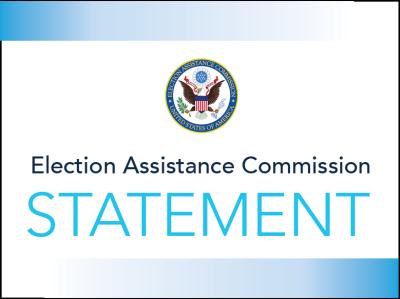
For Immediate Release
December 3, 2020
The following statement from the U.S. Election Assistance Commission (EAC) was approved by Chairman Ben Hovland, Vice Chair Don Palmer, Commissioner Thomas Hicks, and Commissioner Christy McCormick.
Washington, DC - Since Election Day has passed, a lot of attention has been focused on the oversight of voting technology and the companies who manufacturer these systems. The U.S. Election Assistance Commission (EAC) is an independent, bipartisan commission charged with facilitating secure, accurate, and accessible elections by developing guidelines to meet the Help America Vote Act (HAVA) requirements, adopting voluntary voting system guidelines, testing voting systems, accrediting test laboratories, and serving as a national clearinghouse of information on election administration. Under the U.S. Constitution, individual states are mandated with running elections. We, as the only federal agency completely dedicated to election administration, have confidence in the state and local election administrators who ran the 2020 election and the voting systems certified by the EAC.
Below is a summary of the EAC’s role in the testing and certification of voting systems.
Individual states decide how to test and certify their voting systems:
- Thirty-eight states currently use some combination of the EAC’s standards and certification.
- Twelve of these thirty-eight states currently require full EAC certification.
- The remaining states have developed their own guidelines, most based on the EAC’s standards.
To apply for EAC certification, a voting system manufacturer must first register with the agency. This registration requires that details be provided on each manufacturer’s ownership structure, the manufacturer’s quality management and change control systems, and technical and management contacts. Additionally, the application for registration requires that manufacturers agree to the Testing and Certification program’s requirements and quality monitoring program as outlined in the Testing and Certification Manual. There are currently eight active manufacturers registered with the EAC’s program.
Before voting machines and election management systems are used in elections, the systems undergo rigorous hardware and software testing by laboratories accredited by the EAC and the National Institutes of Standards and Technology (NIST). The testing encompasses security, accuracy, functionality, accessibility, usability, and privacy based on requirements in the EAC’s Voluntary Voting System Guidelines (VVSG). There are currently two accredited voting system test laboratories. The full testing cycle, from test plan creation to final determination of a system’s suitability for federal certification, is managed by the EAC’s Testing and Certification program and closely monitored for adherence to all applicable standards.
Individual states perform certification of voting systems which may include a review of a system’s source code as well as the system’s suitability for state-specific election requirements such as straight-party voting, curbside voting, or other functionality not specifically addressed in the EAC’s guidelines.
Additionally, jurisdictions perform a series of tests that include logic and accuracy testing prior to the use of voting machines in polling places. These tests utilize manually created voting patterns that are tested on voting devices to ensure the expected result is accurately reported. This pre-election testing also includes the checking of installed software to ensure that only the certified versions of the software are installed on certified hardware. The EAC provides validation tools to jurisdictions to perform these software checks. Finally, there are numerous post-election related audits that are performed by election officials to both verify the completeness and the accuracy of the vote. These post-election audits also help ensure the proper functioning of voting equipment. The EAC provides resources and direct assistance to jurisdictions wishing to improve their audit capabilities.
For specific information on certified voting systems, please visit the certified voting systems page on EAC.gov.
For information on EAC registered manufacturers, please visit the registered manufacturers page on EAC.gov.
For information on EAC accredited voting system test laboratories, please visit the voting system test laboratory page on EAC.gov.
###
The U.S. Election Assistance Commission (EAC) was established by the Help America Vote Act of 2002 (HAVA). It is an independent, bipartisan commission charged with ensuring secure, accurate and accessible elections by developing guidance to meet HAVA requirements, adopting voluntary voting system guidelines, and serving as a national clearinghouse of information on election administration. EAC also accredits testing laboratories and certifies voting systems, as well as administers the use of HAVA funds. For more information, visit eac.gov.
Contact: Kristen Muthig
Phone: 202-897-9285
Email: [email protected]

